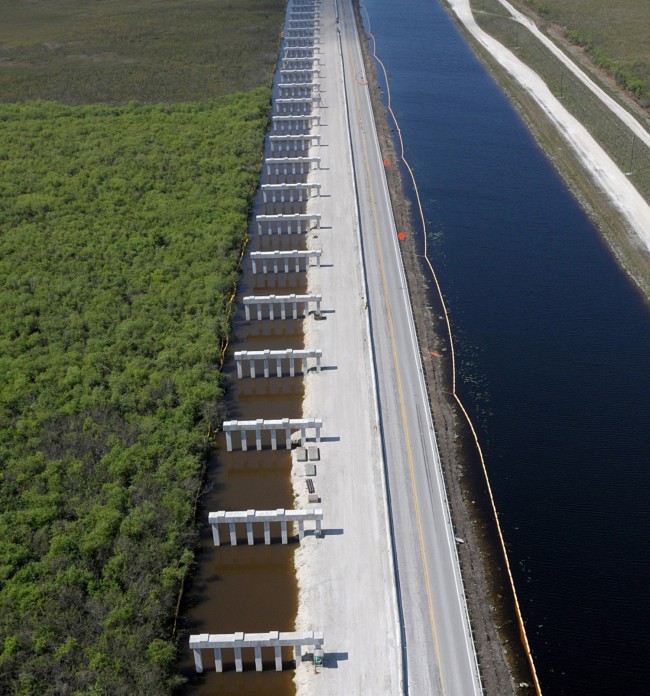
Gov. Rick Scott is proposing $90 million to help lift a section of the Tamiami Trail, which groups such as the Everglades Foundation have called “one of the most prominent dams” blocking the natural flow of the River of Grass.
Money for the bridge project would be spread over three years and would come from the state Department of Transportation. It is expected to match money from the U.S. Department of Interior, keeping construction on pace to be completed by 2017.
The announcement comes as residents on both sides of South Florida have clamored for relief from Lake Okeechobee water discharges that have negatively affected the health of the St. Lucie and Caloosahatchee river systems.
“Every drop of water that we can send south and keep out of the Caloosahatchee and St. Lucie Estuaries is a win for Florida families,” Scott said in a prepared statement after touring the Fort Myers Downtown Detention Basin on Wednesday. “My message to families being impacted is that we will not give up on you. We are putting forward strategies each and every day to address the water quality issues that are impacting families in our state.”
Last week, Scott proposed $40 million to help build a storm-water retention area along the St. Lucie River.
The 2.6-mile bridge along the Tamiami Trail is planned to break up part of a 10-mile stretch of the road in Miami-Dade County that since 1928 has been a buffer to the natural flow of water between Lake Okeechobee and the southern Everglades.
To keep water from constantly flooding the trail, the water levels are kept low by water district managers. The bridge is expected to re-establish historic water depths, providing flexibility to water managers in handling regional flood protection.
Scott’s proposal was quickly backed by Audubon Florida, which said the trail has long left wetlands parched and diverted water flows from wading bird populations in Everglades National Park and Florida Bay.
“The Tamiami Trail bridge is a keystone project that will connect the River of Grass and provide an outlet for dangerously high water levels north of the trail and near the Caloosahatchee and St. Lucie estuaries,” Julie Hill-Gabriel, Audubon’s director of Everglades policy, said in a release. “Endangered wood storks and other iconic birds and wildlife of the Everglades will see tremendous value from the expedited completion of this important phase of the Tamiami Trail bridging project.”
Theresa Pierno, acting president for the National Parks Conservation Association, said “elevating Tamiami Trail is vital to protect critical habitat, restore historic water flows into Everglades National Park and Florida Bay, and ensure America’s Everglades will be preserved for future generations.”
The federal government has been trying for months to sway the state to be a financial partner on the span. Secretary of the Interior Sally Jewell welcomed Scott’s partnership in the estimated $170 million to $210 million project.
“I visited the Everglades during my first two weeks as interior secretary and I am struck by the scale of the restoration effort and by the strength of the partnership we have with the state of Florida,” Jewell said in a release. “I commend Gov. Scott for his leadership on the Everglades and look forward to our continued joint efforts to restore this critical ecosystem while creating jobs and strengthening Florida’s economy.”
President Barack Obama has proposed $30 million this year for the bridge. The budget allocation remains before Congress.
The bridge, which could start to go up in late 2014 if design and build plans are completed early next year, would be the second in that stretch of roadway.
The U.S. Army Corps of Engineers had proposed an 11-mile bridge in 2005, but Congress allocated just enough money to lift one mile of road.
The proposed structure is less than half of what was proposed in an environmental impact statement by the U.S. Department of the Interior’s National Park Service in May 2010.
The National Park Service began planning the 2.6-mile span in January, just before the estimated $130 million, federally-funded, one-mile-long bridge was completed.
The proposal is the second time this month that Scott, often a critic of federal spending, has pitched federal projects involving South Florida waterways.
Scott announced Aug. 20 that he would float a $40 million proposal to the state Legislature next year that would speed completion of a federal project intended to help clean water released from Lake Okeechobee onto the St. Lucie River.
Sen. Joe Negron, a Stuart Republican who heads the powerful Senate Appropriations Committee, has already backed the proposal, adding he would support up to $100 million in funding for Everglades restoration.
Negron’s Senate Select Committee on Indian River Lagoon and Lake Okeechobee Basin is also going to consider a number of short-term fixes to lessen the lake discharges later this year, including: cleaning the water that comes into the lake from the Kissimmee River; reducing nutrients from septic tanks; raising the allowed water levels in canals by a few inches; and getting Scott to declare a state of emergency for the lake to force the U.S. Army Corps of Engineers to reevaluate the lake protection plan.
The St. Lucie County Commission on Tuesday directed its staff to work with government officials in Martin County on asking Scott to declare a state of emergency for the Indian River Lagoon and St. Lucie River estuary. The hope is to use the declaration to seek money from the Federal Emergency Management Agency for the river cleanup.
–Jim Turner, News Service of Florida





























Sherry Epley says
Occasionally the political need to do the “right thing” to get re-elected creates wonderful things. Thanks Rick. . . but YOU STILL NEED TO GO!